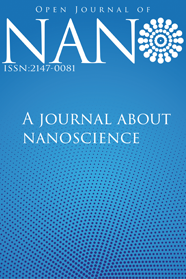Synthesis and Photophysical Properties of Pyrene-BODIPY Functionalized Subphthalocyanine Dyad
The treatment of boron(III) subphthalocyanine chloride (SubPcCl) with borondipyrromethene (BODIPY) derivative consisting one pyrene group in toluene gave the corresponding axially substituted boron(III) subphthalocyanine dyad (SubPcBodiPy). Novel compound has been fully characterized by FTIR, mass, NMR (1H and 13C) spectroscopy and elemental analysis. Photophysical properties of SubPcBodiPy was investigated and compared with its precursors by fluorescence and absorption spectroscopy in THF. Accordingly, fluorescence lifetimes were measured directly by single exponential calculation.
Anahtar Kelimeler:
Subphthalocynanine, BODIPY, pyrene, photophysical properties
Synthesis and Photophysical Properties of Pyrene-BODIPY Functionalized Subphthalocyanine Dyad
The treatment of boron(III) subphthalocyanine chloride (SubPcCl) with borondipyrromethene (BODIPY) derivative consisting one pyrene group in toluene gave the corresponding axially substituted boron(III) subphthalocyanine dyad (SubPcBodiPy). Novel compound has been fully characterized by FTIR, mass, NMR (1H and 13C) spectroscopy and elemental analysis. Photophysical properties of SubPcBodiPy was investigated and compared with its precursors by fluorescence and absorption spectroscopy in THF. Accordingly, fluorescence lifetimes were measured directly by single exponential calculation.
Keywords:
Subphthalocynanine, BODIPY, pyrene, photophysical properties,
___
- Ward M. D., (1997) “Photo-induced electron and energy transfer in non-covalently bonded supramolecular assemblies”, Chemical Society Reviews, vol.26, pp.365-375.
- Balzani V., Bergamini G., Ceroni P., (2008) “From the photochemistry of coordination compounds to light-powered nanoscale devices and machines”, Coordination Chemistry Reviews, vol. 252, pp.2456-2469.
- Holten D., Bocian D. F., Lindsey J. S., (2002) “Probing electronic communication in covalently linked multiporphyrin arrays. A guide to the rational design of molecular photonic devices” Accounts of Chemical Research, vol.35, pp.57-69.
- Loudet A., Burgess K., (2007) “BODIPY dyes and their derivatives: syntheses and spectroscopic properties” Chemical Reviews, vol.107, pp.4891-4932.
- Claessens C. G., González-Rodríguez D., Torres T., (2002) “Subphthalocyanines: singular nonplanar aromatic compounds synthesis, reactivity, and physical properties” Chemical Reviews, vol.102, pp.835-854.
- Mutolo K.L., Mayo E.I., Rand B.P., Forrest S.R., Thompson M.E., (2006) “Enhanced opencircuit voltage in subphthalocyanine/C60 organic photovoltaic cells” Journal of American Chemical Society, vol.128, pp.8108-8109.
- Xu S., Chen K., Tian H., (2005) “A colorimetric and fluorescent chemodosimeter: fluoride ion sensing by an axial-substituted subphthalocyanine” Journal of Materials Chemistry A, vol.15, pp.2676-2680.
- Morse G. E., Helander M. G., Maka J. F., Lu Z. H., Bender T. P., (2010) “Fluorinated phenoxy boron subphthalocyanines in organic light-emitting diodes” ACS Applied Materials & Interfaces, vol.2(7), pp.1934-1944.
- Renshaw K. C., Xu X., Forrest S. R., (2010) “A monolithically integrated organic photodetector and thin film transistor” Organic Electronics, vol.11, pp.175-178.
- Li J. Y., Yeung H. S., Xu W., Li X., Ng D. K. P. (2008) “Highly Efficient Energy Transfer in Subphthalocyanine−BODIPY Conjugates” Organic Letters, vol.10, 23, pp.5421–5424.
- Yayın Aralığı: Yılda 2 Sayı
- Başlangıç: 2012
- Yayıncı: Mustafa CAN
Sayıdaki Diğer Makaleler
Alternatif Karışım Yöntemleri ile F tipi Uçucu Külünün Çimento Harcı İçerisinde Kullanımı
Modification of PVDF Membranes Using Dopamine/Zinc Oxide for Lead Removal from Aqueous Media
Synthesis and Photophysical Properties of Pyrene-BODIPY Functionalized Subphthalocyanine Dyad
